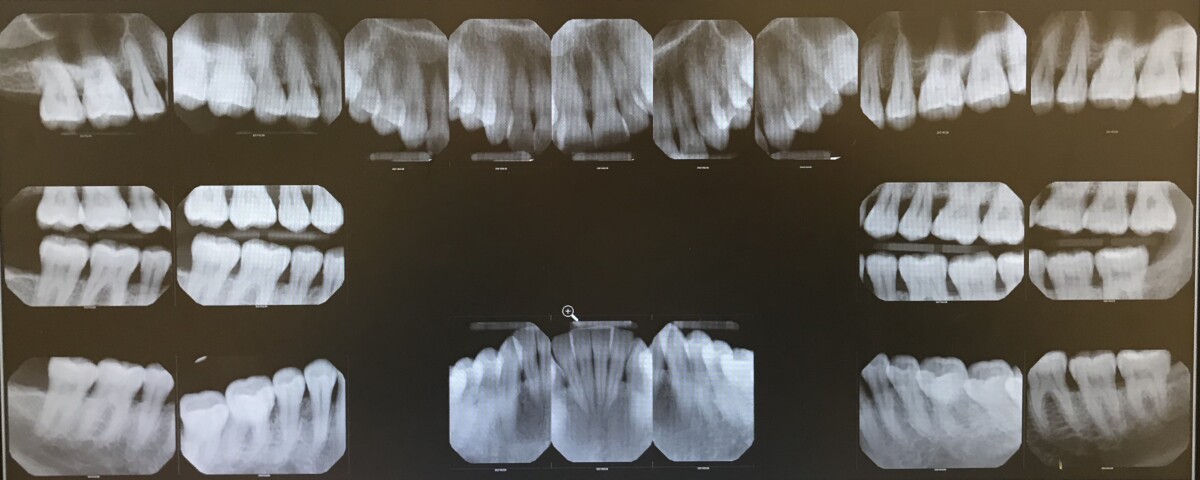In March, I had a new patient (36 year old Turkish female) with a recently broken collarbone. She is a friend of mine and she thought she should come in for a cleaning because she noticed some bleeding when she brushed her teeth. She stated her last cleaning was about 2 years ago. She believed she had “some gingivitis” that was being exacerbated by her inability to perform proper oral hygiene due to her recent injury. Her medications are as follows:
Ultram 50mg (as needed for pain); Xanax .5mg (as needed for anxiety/sleep); Supplements: Vitamin D and curcumin.
She had surgery to remove a lipoma about 4 years ago, but no other surgeries or conditions to note. Her blood pressure was 105/79, pulse 54. She reports using a manual toothbrush with Tom’s toothpaste and flosses every night (before injury). She drinks alcohol daily (about 3 drinks) and has a history of heavy smoking. She has been working on smoking cessation and is currently down to about 1 cigarette per day. Her last physical was August of 2020, but is currently under the care of an orthopedist for her collarbone, whose words I echoed when I reminded her of the connection between smoking and bone healing.
Upon visual inspection during assessments, it was immediately clear there was much more than gingivitis taking place. Her gingiva was generalized severely inflamed with blunted, flaccid papillae. She also had heavy localized BOP and heavy visible calculus present. I believe her probing depths were worse than recorded due to the presence of subgingival calculus and her severe sensitivity. She was adamantly against having any sort of injection for pain management.
It was clear that we needed radiographs to accurately assess her condition. After exposing a full mouth series, I was faced with what I consider the hardest part of a dental hygienist’s job – effectively explaining the severity of someone’s situation without scaring them away. There was radiographic evidence of subgingival calculus, but what’s worse is her bone loss. She had generalized bone loss, but in the anterior it was much more severe, <50%. At age 36, this is really cause for concern. Combine the challenge of clarifying this situation for her with the fact that she is my friend and someone I hold dear, my job becomes even harder.
Due to time constraints, I was only able to begin hand-scaling quadrant 1 while utilizing Oraquix. I wanted to thoroughly go over the radiographs with the attending dentist and get pointers on vocabulary to use before informing my patient, and friend, of the extent of her periodontal status. Based on her bone loss and smoking status, she is classified as Periodontitis Stage III, Grade C. The dentist, whom I consulted, was also very concerned when he saw the radiographs and suggested I encourage her to consider being tested for bone disorders, and naturally, to stop smoking completely.
I made a treatment plan for 2 more visits to clean 2 quadrants each visit, with the use of Oraquix. Despite my urging, she could not be swayed to consider local anesthesia for a better experience. As predicted, her next visit was not a pleasant one. I gave it my best shot to inform her about the extent of her periodontal disease,. It was obvious when I started talking, that she did not want to hear what I had to say. When I suggested the bone density tests, she actually interrupted and mumbled something with the shake of her hand, insinuating that I should stop talking. As a healthcare provider, it is important to know when to stop talking. If the patient is clearly not receptive to what we are saying, we could make matters worse by forcing the information on them.
The Oraquix only helped to a degree, and the extent of bleeding during scaling was severe. I could tell she was very stressed out, but the one thing she knew for sure was that she did not want an injection. If I could have convinced her in utilizing local anesthesia, she might have returned to finish her treatment. Two days before her last appointment, to scale quadrants 2 and 3, she canceled. Her reason, ironically, was that her orthopedist called her in for a CT scan because her broken collarbone was not healing properly. (The scan later revealed she needed surgery).
We could be the most educated and skilled hygienist in the United States, but if we don’t consider the way we communicate to our our patients, we are doing them a disservice. As healthcare professionals, we sometimes have to have uncomfortable conversations with our patients. We must always remember that their health and wellbeing are of utmost importance. The way we communicate with them could make the difference between whether or not they accept the treatment that they need.





